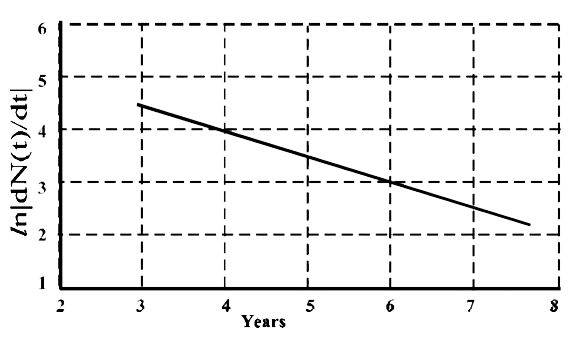Describes the properties of radiations which are emitted by radioactive nuclei.
Characteristics of alpha (α) particles
a. Nature : An alpha particle is a helium atom from which two electrons have been removed.
b. Mass and charge : An alpha particle has a mass of 4aμ and a charge of +2 units. Therefore, symbol of an alpha particle is .2He4. ltbr> c. Speed : Alpha particles have a low speed of upto 10% of the speed of light. ltbr> d. Penetrating power : These ray can penetrate an aluminium sheet of 0.002cm thickness.
e. Effect of electric field : Alpha particles are positively charged and are deflected strongely by an electrostatic field.
Characteristics of beta (β) particles ltbr> a. Nature : These rays are made up of stream of electrons.
b. Mass and charge : The mass of a beta particle is 1/1840amu and the charge of a beta particle is −1 unit. The mass of a beta particle is so small that it is taken to be zero in the nuclear reactioins. The symbol of the beta particles is .−1e0
c. Speed : The speed of beta particles is 90% of the speed of light and 10 times that of α− particles.
d. Penetrating power : They can penetrate an aluminium sheet of upto 0.2cm thickness.
e. Effect of electric field : They are heavily deflected by an electrostatic field because of their relatively smaller momentum compared to α− rays.
Charactersitics of gamms (γ) rays
a. Nature : Gamma rays are electro− magentic radiations with a very short wavelength of the order of 10±.
b. Mass and charge : Gamma rays have no mass and no charge. A gamma ray is represented by the symbol .0γ0. ltbr> c. Speed: Gamma rays travel with the speed of light.
d. Penetrating power : Gamma rays can penetrate upto 100cm thick aluminium sheet.
e. Effect of electric field : Gamma rays are not deflected by an electrostatic field because of the absence of charge and mass associated with them.
Topper's Solved these Questions
- NCERT BASED EXERCISEBOOK - CENGAGE CHEMISTRY ENGLISHCHAPTER - NCERT BASED EXERCISEEXERCISE - Surface Chemistry (In-Text Question)
8 Videos
- GRIGNARD REAGENTS AND ORGANOMETALLIC REAGENTSBOOK - CENGAGE CHEMISTRY ENGLISHCHAPTER - GRIGNARD REAGENTS AND ORGANOMETALLIC REAGENTSEXERCISE - Exercises Archives (Linked Comprehension)
1 Videos
- NUCLEAR CHEMISTRYBOOK - CENGAGE CHEMISTRY ENGLISHCHAPTER - NUCLEAR CHEMISTRYEXERCISE - Archives Subjective
13 Videos
Similar Questions
To determine the half life of a radioactive element , a student plot a graph of in ∣∣∣dN(t)dt∣∣∣ versus t , Here ∣∣∣dN(t)dt∣∣∣ is the rate of radiation decay at time t , if the number of radioactive nuclei of this element decreases by a factor of p after 4.16year the value of p is

View SolutionSome radioactive nucleus may emit.
View SolutionName three properties of ultraviolet radiations which are similar to visible light
View SolutionDescribe the important properties of enzymes.
View SolutionDescribe some unusual properties of water.
View SolutionDescribe two reducing properties of dihydrogen?
View SolutionGive two properties of infrared radiations which differ from visible light.
View SolutionDescribe one example of adaptive radiation.
View SolutionDescribe one example of adaptive radiation.
View SolutionGive two properties of ultraviolet radiations which differ from visible light.
View Solution
